The Illustrated Guide To Boat Hull Types (11 Examples)
I didn't understand anything about boat hull types. So I've researched what hulls I need for different conditions. Here's a complete list of the most common hulls.
What are the different boat hull types? There are three boat hull categories: displacement hulls, which displace water when moving; planing hulls, which create lift at high speeds; and semi-displacement hulls, which displace water and generate lift at low speeds. The most common hull types are round-bottomed, flat-bottomed, multi, V-shaped, and pontoon hulls.
But that's all pretty abstract if you ask me, so below I'll give a simple overview of what it all means. After that, I'll give a list with pictures of all the different designs.
A Simple Overview of Boat Hull Types
Your boat hull will be the biggest factor in how your boat handles or sails, how wet it is, how bumpy - absolutely everything is determined by the hull shape. So it's important to understand what different hulls will do for you, and what each hull is best for. First, let's slice it up into rough categories.
Roughly, you can divide boat hulls into three categories:
- Displacement hulls - Lie inside the water and push it away when they move
- Planing hulls - Lie on top of the water and don't push it away
- Semi-displacement hulls - Lie inside the water and push it away, but can generate lift
Everything I'll be mentioning below is one of those three, or something in between.
There are five common boat hull types:
- Round-bottomed hulls - handle well in rough water: sailboats
- Flat-bottomed hulls - very stable for calm inland waters: fishing boats
- Multihulls - very stable and buoyant: catamarans
- V-Shaped Hulls - fast and comfortable in chop: powerboats
- Pontoon hulls - fast and stable: pontoon boats
And then there's everything in-between.
Here's a quick and handy overview of the different hull types
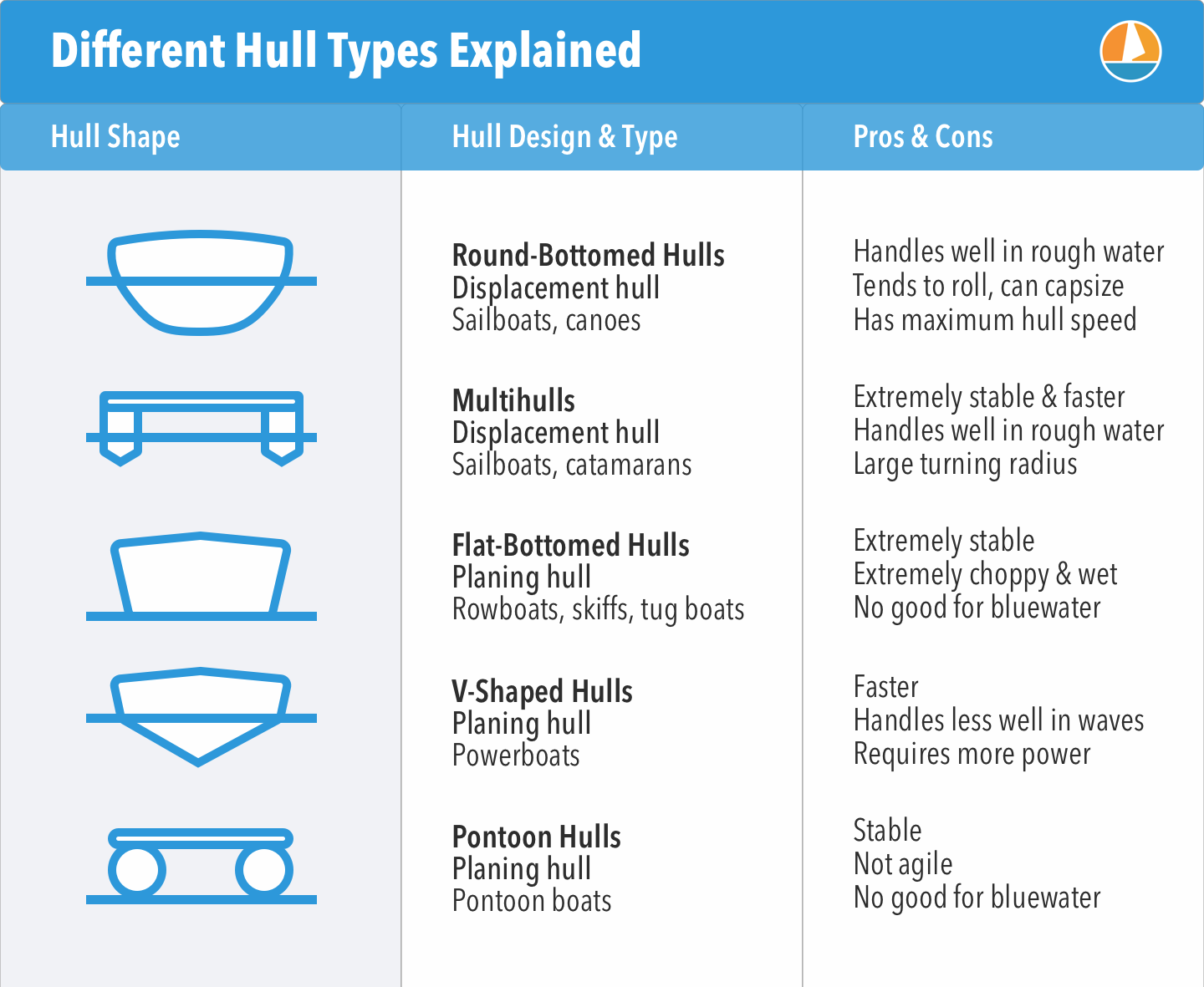
In each category, we find different designs and styles that have different characteristics. There isn't a real clear distinction between categories and styles: there are semi-displacement hulls and so on. So I thought the best way to learn you the different hull types is by simply creating a list with lots of pictures, instead of getting all theoretical about it.
So below I've listed all the different hull styles I could possibly think of, mention what category and type it is, the pros and cons of each one, and give you examples and illustrations for each one.

On this page:
Displacement Hulls
Examples: Sailboats, trawlers, fishing boats
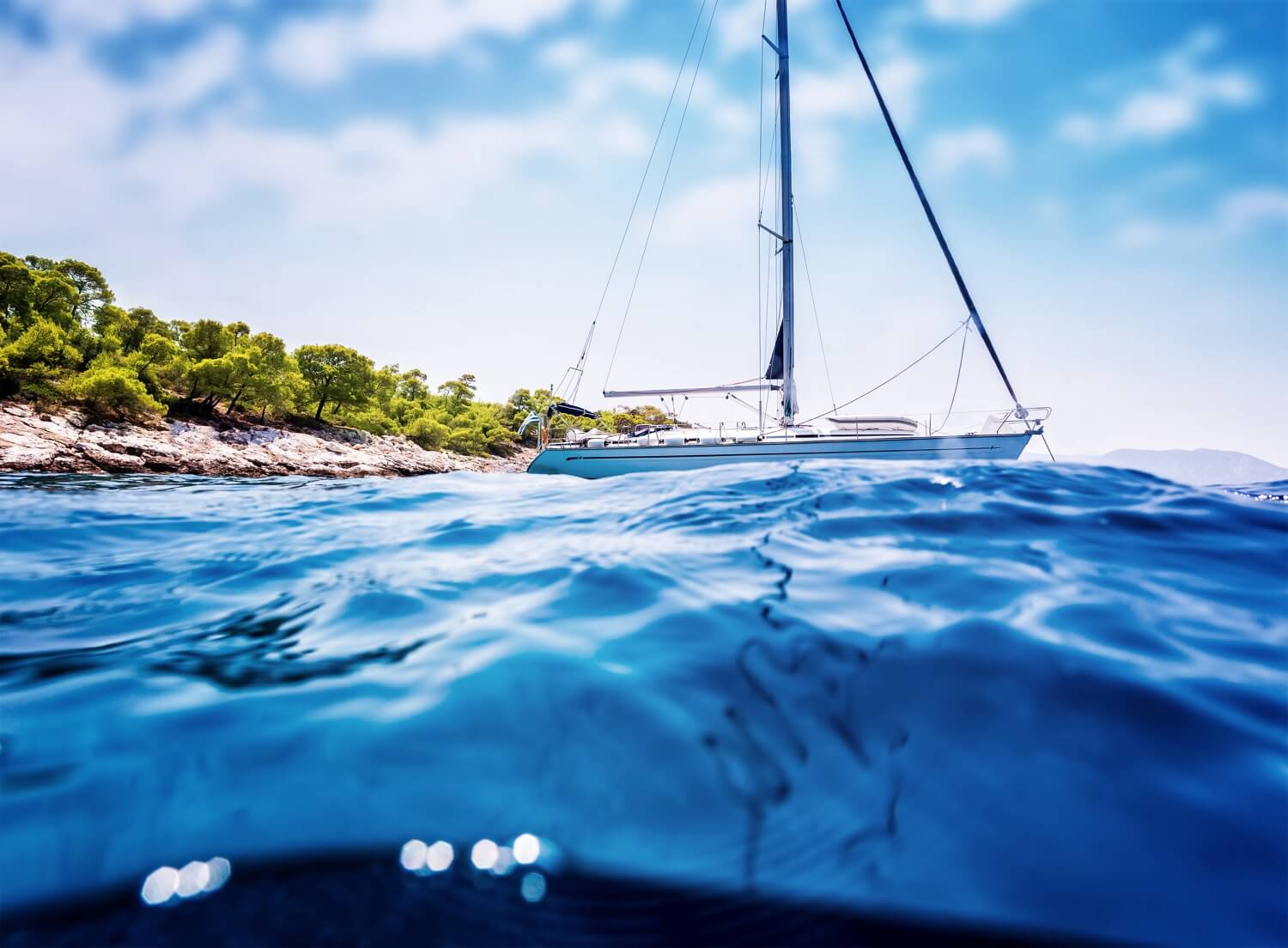
Displacement hulls displace water when moving. These hulls lie in the water, instead of on top of it. The amount of water they displace is equal to the boat's weight. Displacement hulls handle way better in rough waters than flat-bottom hulls. That's why most cruisers have some sort of displacement hulls. There are actually all kinds, shapes, and forms of the displacement hull design, which we'll go over later.
The most important thing to understand about the displacement hull, is that it operates on buoyancy. This means that most of the boat's weight is supported by its capacity to float. Planing hulls, on the other hand, operate on lift instead, but we'll dive into that later.
Sailboats typically have displacement hulls, but also fishing boats, trawlers and crabbers. All in all, it's used for each boat that needs to handle well in rough conditions.
Learn everything there is to know about displacement hulls in this article. It lists all the pros and cons and really goes into detail on the nitty-gritty about how displacement hulls actually work.
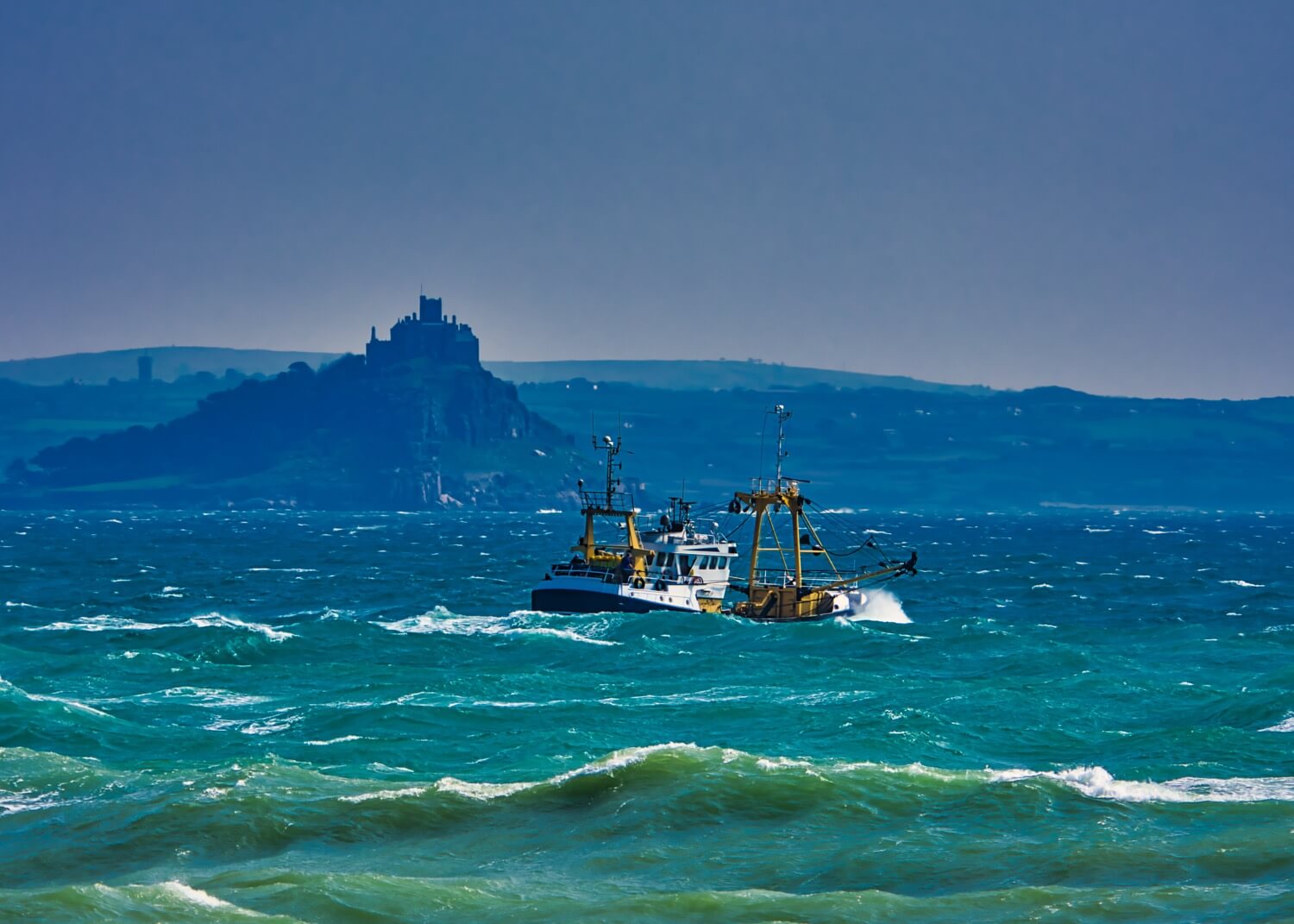
But they are also slower than flat and planing hulls because the boat creates more resistance when moving. It has to push the water aside. In fact, this type of hull has a built-in upper-speed limit.
This upper-speed limit is called maximum hull speed. It means that the length of a displacement hull directly determines the maximum speed. It can't go faster, because the water-resistance increases with the boat's speed. To learn everything about calculating maximum hull speed, please check out my previous article here.
Round-Bottom Hull
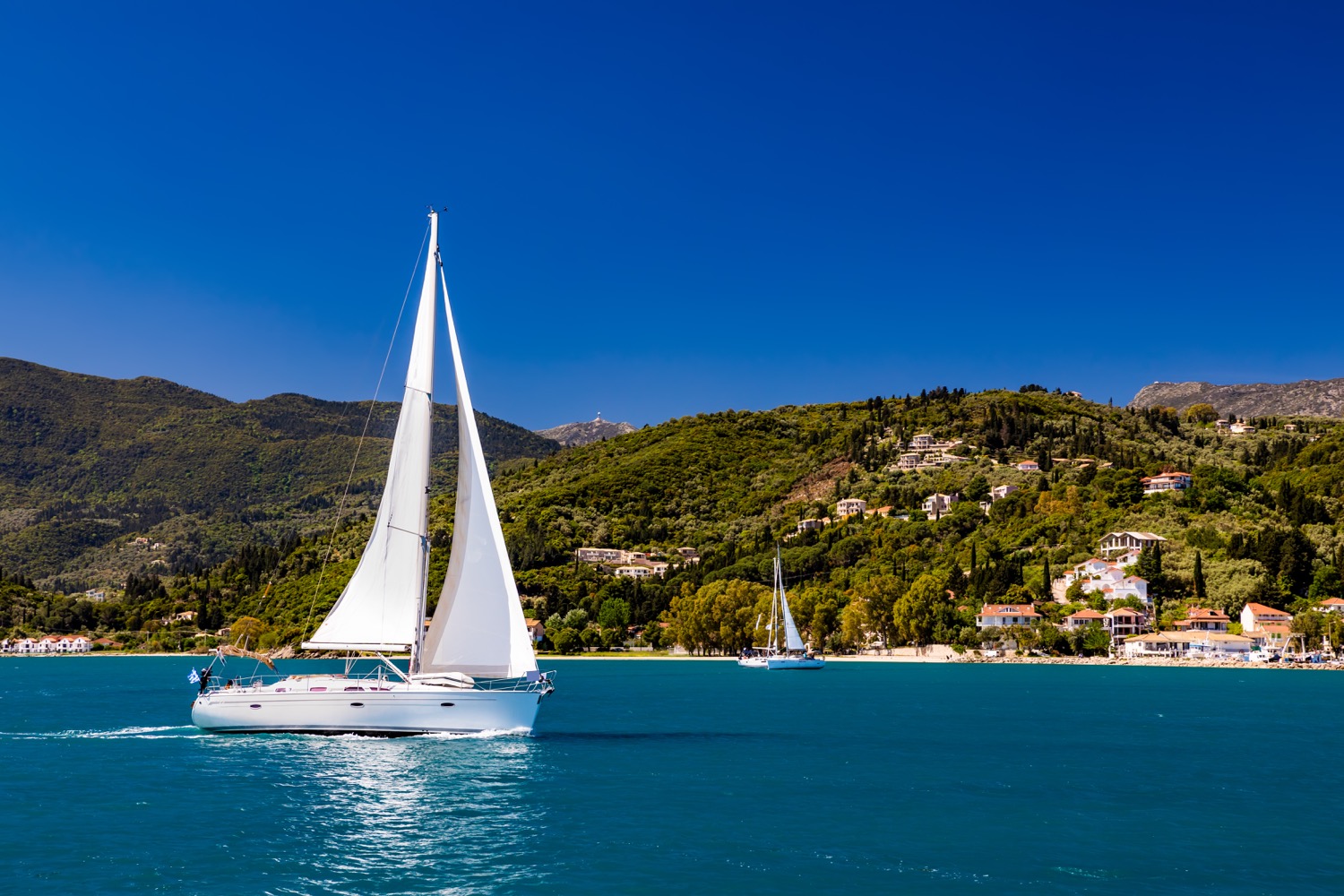
A round-bottomed hull is a type of displacement hull - it lies in the water and has to power through it. But since it's rounded, it creates little resistance and is effortless to move through the water. It's a very smooth ride and typical for any sailboat that sort of glides through the waves. In contrast, powerboats really have to eat their way through the water.
Examples: Canoes, sailboats
They are also one of the least stable. Since the bottom is rounded, your boat or canoe will rock plenty when boarding or moving around. They are also easy to capsize. That's why pro canoers learn to do a 360 in their canoes. I've never did a roll myself but came close enough a couple of times.
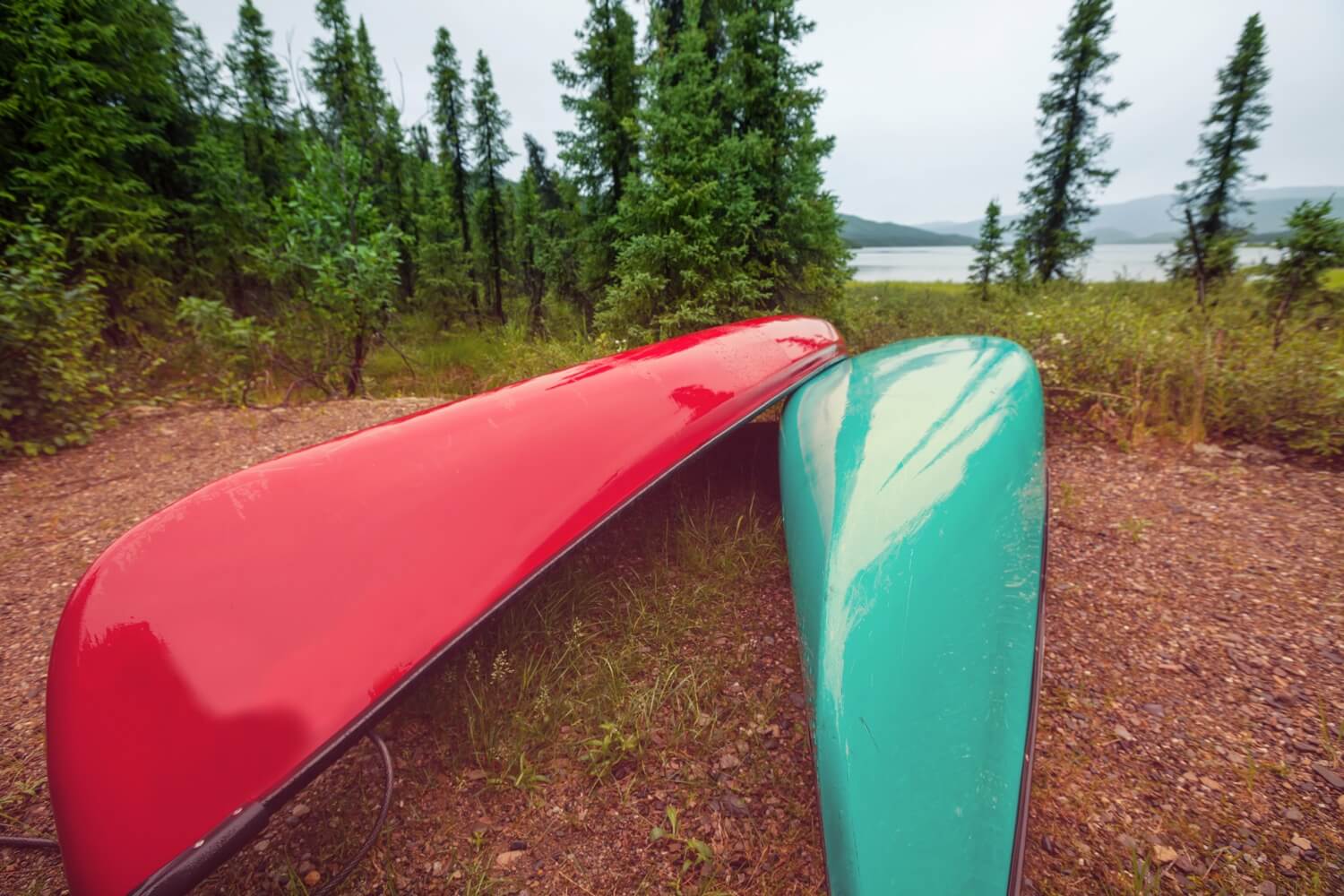
Almost all sailboats use a round bilge as well. This provides it its buoyancy and makes sure it handles well in waves. But since a rounded bilge is easy to capsize, a lot of sailboats have some sort of keel, which stabilizes the roll.
Nearly all ocean-going vessels use some sort of displacement hull, and the round bottom is the most common one. But our next guest is very popular as well.
Catamaran Hull
The catamaran is similar to the pontoon hull (read on to learn more on that one), but it is a displacement multihull instead of a planing one. So it has two hulls, that lie inside the water and displace it. Like the pontoon, you will have to try really hard to capsize this design (and it won't work).
Examples: well, catamaran sailboats. But also this cool catamaran trawler:
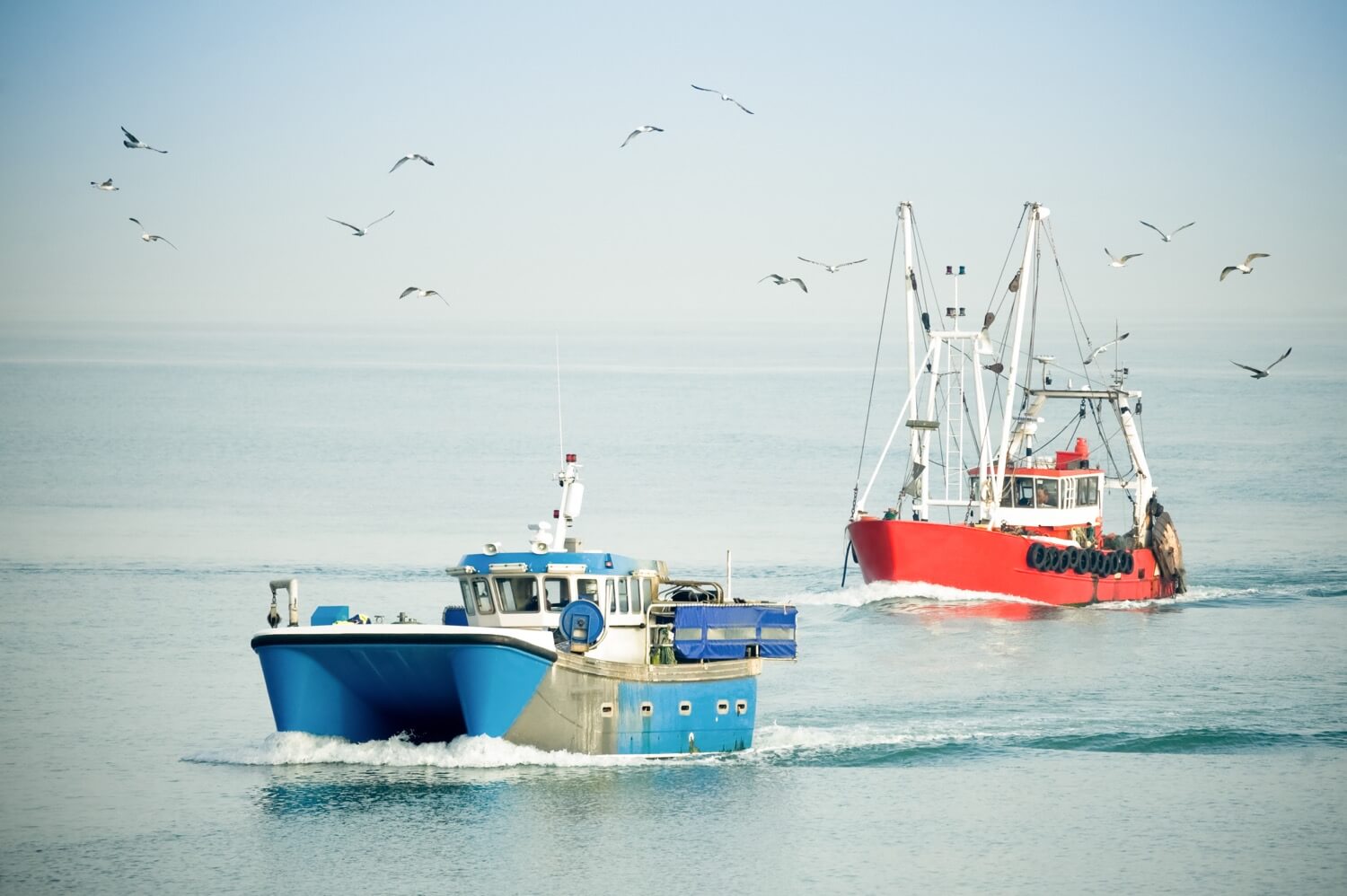
Catamarans are extremely popular ocean cruisers. Their biggest pro is their extreme stability and buoyancy. And they have a very shallow draft for a displacement hull, making them very popular for sailing reefs and shallow waters, like the Caribbean.
Some cons for the catamaran are less agile than monohulls. They have a large turning radius, making them less maneuverable. Also, expect to pay high marina fees with this one.
Speaking of marina fees, our next one can go either way.
Trimaran Hull
I think trimarans are incredibly cool, and especially the second type.
There are two types of trimarans:
- a catamaran with three hulls instead of two,
- or a displacement monohull with two floaters.
The first has the same characteristics as the catamaran: it's a displacement multihull, but now with three hulls:

The second can be a regular displacement monohull, with two pontoon-type floaters that provide extra buoyancy, making the total thing a hybrid between pontoon and displacement:
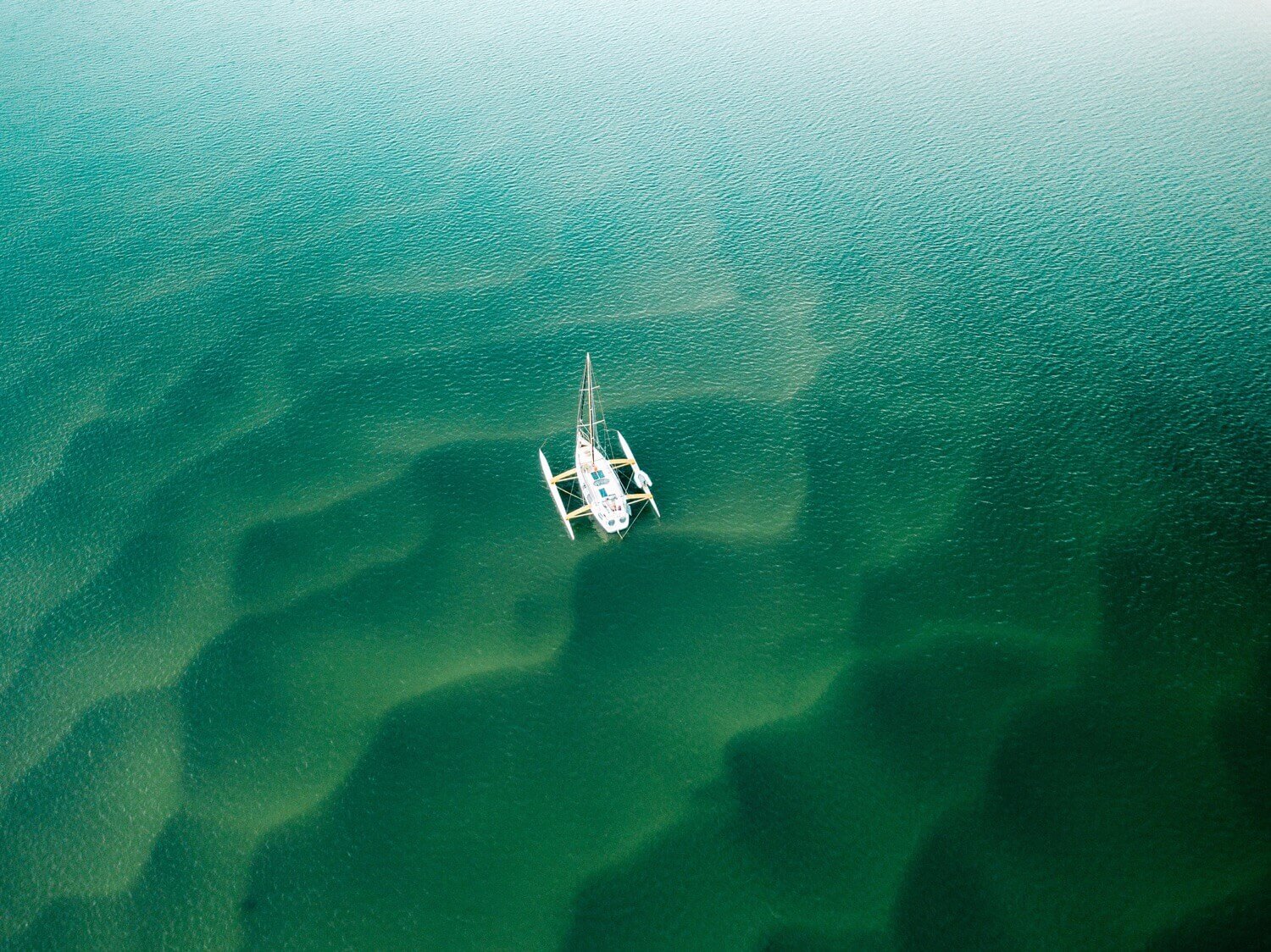
This last one has all the pros of a catamaran in terms of stability, but: you can simply wheel in those floaters whenever you head for port. That saves you a lot of money. And you can trailer her! Imagine that, a towing a trimaran home.
So those were the most common displacement hulls, aka what lives in the water. Let's move on to the planing hulls, aka what lives on the water.
Planing Hulls
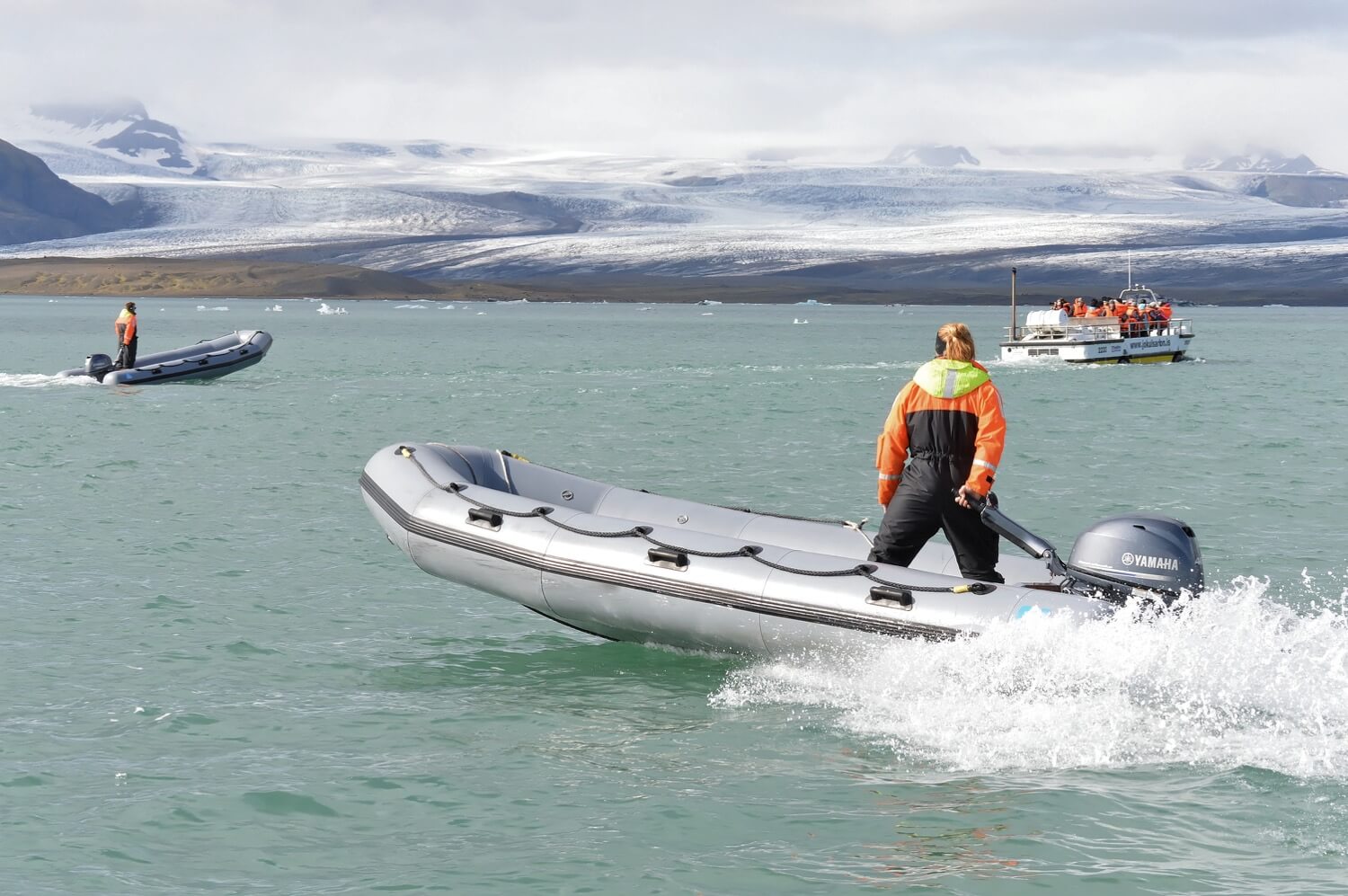
Planing hulls are a hybrid between the flat-bottom and displacement hulls. Planing hulls displace water at low speeds, but create lift at higher speeds. The shape of their hull + speed lifts them out of the water, making them glide on top of the water. Most powerboats look like flat-bottom boats but use a shallow V-shape that helps the boat to handle better at higher speeds.
Examples: Water sports boat, powerboats
The most important thing to understand about planing hulls is that they operate mainly on lift instead of buoyancy. This means the weight of the boat is mainly supported by dynamic forces1. With the right amount of power, this design generates lift, which results in less resistance. This is why they are a lot faster than boats with displacement hulls, but also a lot rougher, even with mild chop.
A lot of powerboats use some sort of planing hull. Again, there are many designs and variations on the planing hull, and I'll try to mention as many as I can below.
Because the wedge of the hull runs into the water, it is much easier to handle at high speeds. At lower speeds, it is able to keep its course, even with a bit of wind. However, whenever the boat starts planing, it is prone to wind gusts, since the wedge shape no longer stabilizes the boat.
The flatter the hull, the faster it will go, but also the more poorly it will handle. Other powerboats use deep V-hulls, which I'll discuss below. But first, let's take a look at the flattest hulls you'll ever see.
Flat-Bottom Hull
A flat-bottom hull lies on top of the water and doesn't displace water (okay, very little) as it moves. Since there is no displacement, there is also little to no friction when moving. This makes it potentially fast, but it handles pretty poorly. It is one of the most stable hull design.
Examples: rowboats, (old) high-performance powerboats, small skiffs, small fishing boats, tug boats
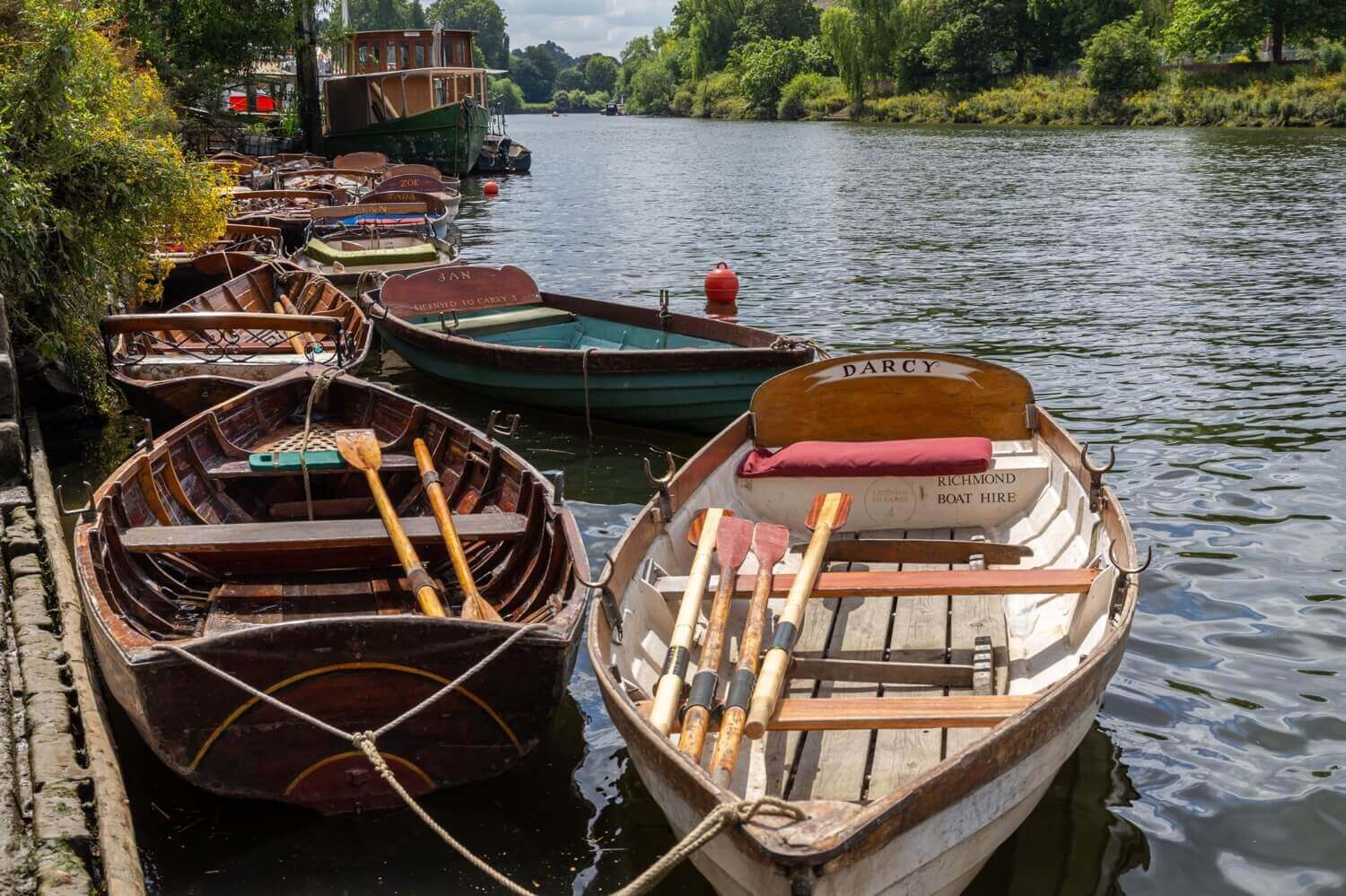
They aren't just incredibly stable, they're also very practical. Because the bottom is practically flat, they maximize boat surface. But they are also extremely choppy in rough weather and waves. They will handle very poorly with stiff winds, as the wind can simply catch them and blow them across the water surface. That's why this design is almost exclusively used for calm, small, inland waters.
This type of hull operates mainly on buoyancy, like the displacement hull, but it doesn't require the same amount of power to propel, which is why it's faster.
Because of the uncomfortable ride, not a lot of boats use a perfectly flat bottom. Most boats nowadays use some sort of v-hull or hybrid design, like a semi-displacement hull; especially larger boats. So not a lot of boats have a real flat bottom. However, we do call a lot of boats flat-bottomed. How come?
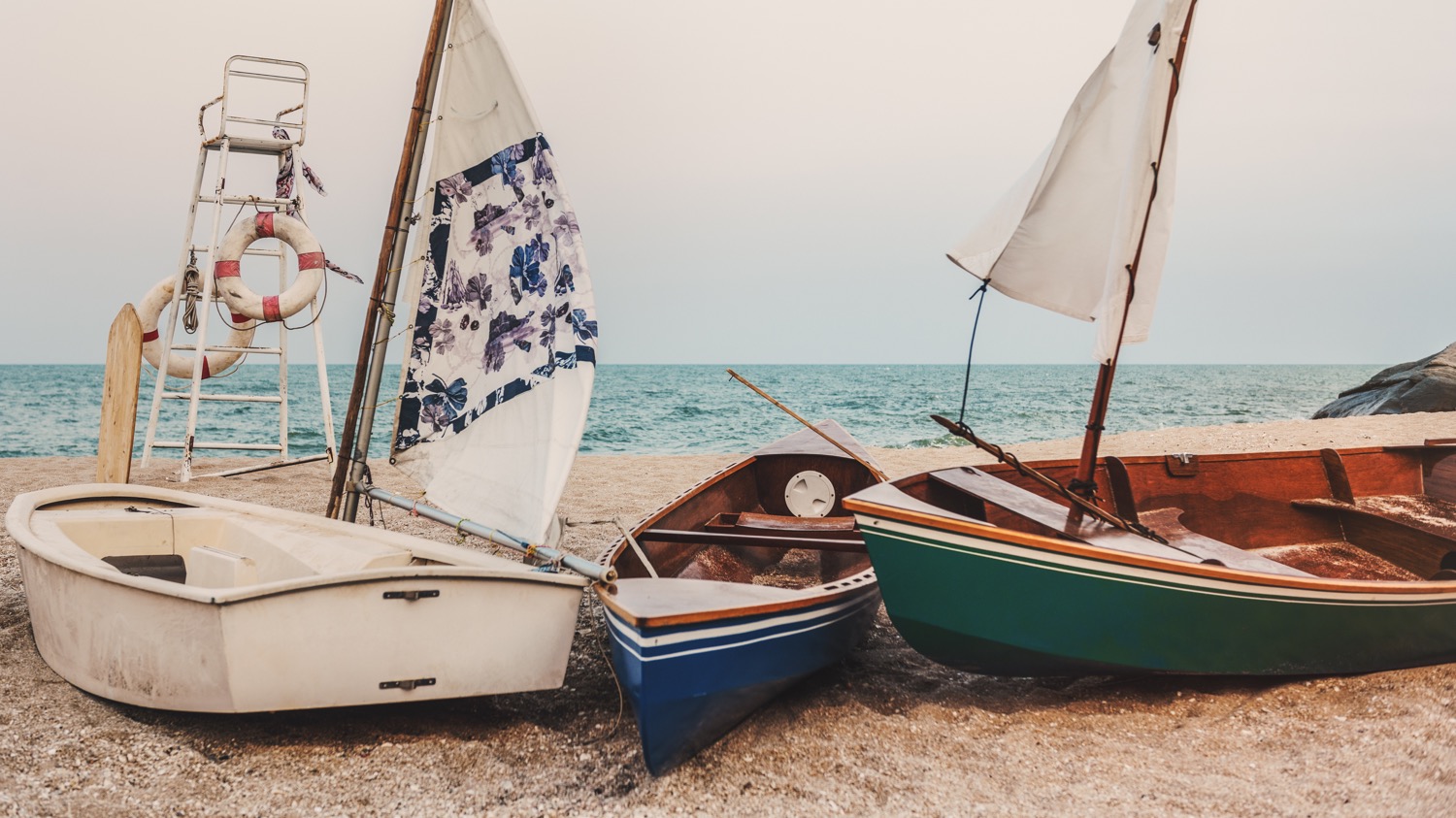
There are two types of hulls we call flat-bottoms:
- Of course boats with an actual flat bottom
- Boats with almost no deadrise
What is the hull's deadrise? The deadrise is the angle of the front of the hull to the horizontal waterline.
As you can see, the green sailing dinghy in the picture above has a deadrise that's barely noticeable.
Let's move on to other variations of the planing hull. One of the most popular hull design for modern-day powerboats is the Deep Vee hull. And that's as cool as it sounds.
Deep V-Hull
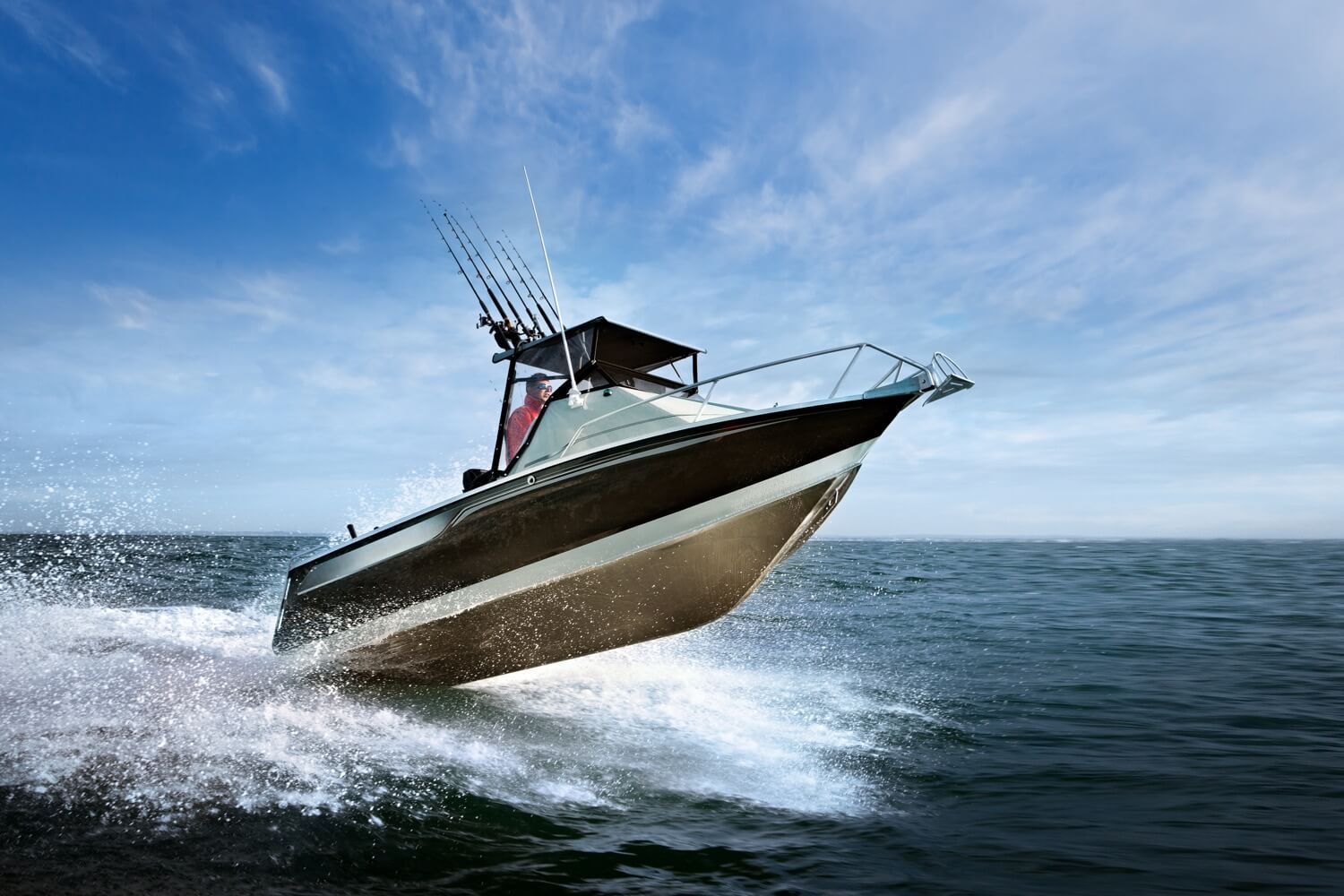
This is a type of planing hull that combines the best of both worlds.
These types of hulls are very popular on modern-day powerboats, and no wonder. With a V-shape that runs from bow to stern, deep into the water, you can handle this boat even in offshore conditions. It handles a lot better than flat-bottomed hulls, while it's at the same time extremely fast.
Examples: Most modern powerboats.
The Deep V-shape acts as a tiny keel of sorts, stabilizing the boat and making it more reliable and maneuverable. The rest of the hull acts as a planing hull, giving the boat its fast edge. Even at high speeds, the Deep V will cut into the water, making it more handleable.
The deep-V design is just one of many variants on the V-hull. Below we'll talk over another, the modified V hull.
Modified-V Hull
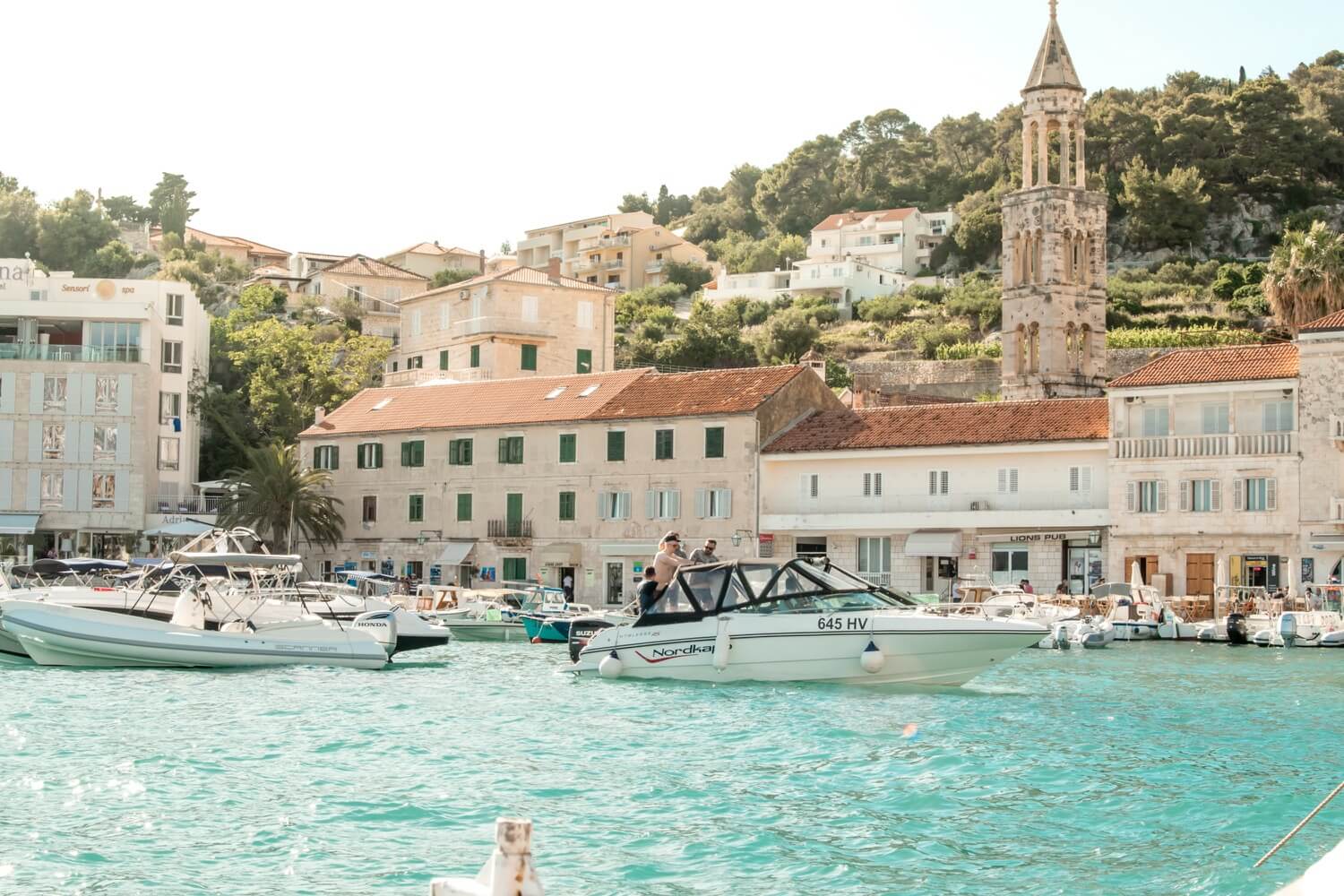
The modified V hull is the ultimate crossover of all planing hull types. It's a mix of the flat-bottom and Deep V hull. It is one of the most popular hull designs for small motorboats. It's flat in the back and then runs into a narrow V-shape to the front. The flat back makes it more stable, and adds a little speed, while the V-shape front ensures good handling.
It is, in short, kind of the compromise-family-sedan of boat hulls. It's the fastest design that's also stable, that's also safe, and that also handles well. But it's not the best in any of those things.
Most powerboats you've seen will have some sort of Vee or Modified-V hull.
Stepped Hull
Stepped hulls are used on high-performance powerboats. It's a type of planing hull that reduces the hull surface by adding steps, or indents in the hull below the waterline. It looks something like this:
It is said to work extremely well at high speed (60 knots and up) and adds up to 10 knots to your top speed.
On to our next design. There are also planing multihulls, and they might even look like catamarans to you. Meet the pontoon hull.
Pontoon Hull
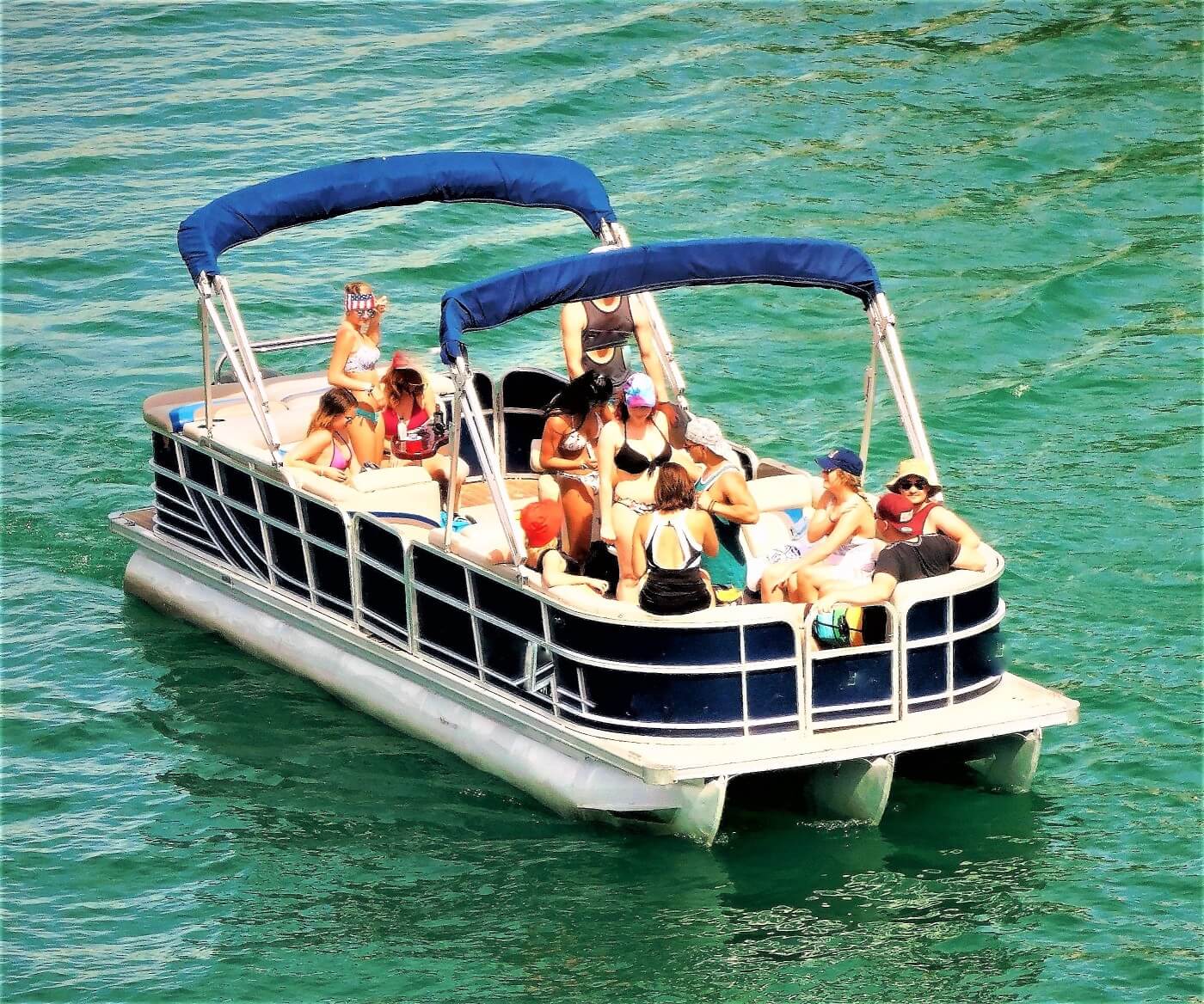
Pontoon hulls float on top of the water using pontoons or floaters that create lift. It's a type of planing multihull that doesn't lie in the water, so it doesn't displace a lot of water. They don't really handle well. As with any multihull, they aren't agile - they're not great at maneuvering. They also have a very large turning radius. But they are extremely stable: there's no chance you'll capsize this.
Semi-Displacement Hulls
Examples: Cruisers, modern trawlers, motor yachts, Maine lobster boats
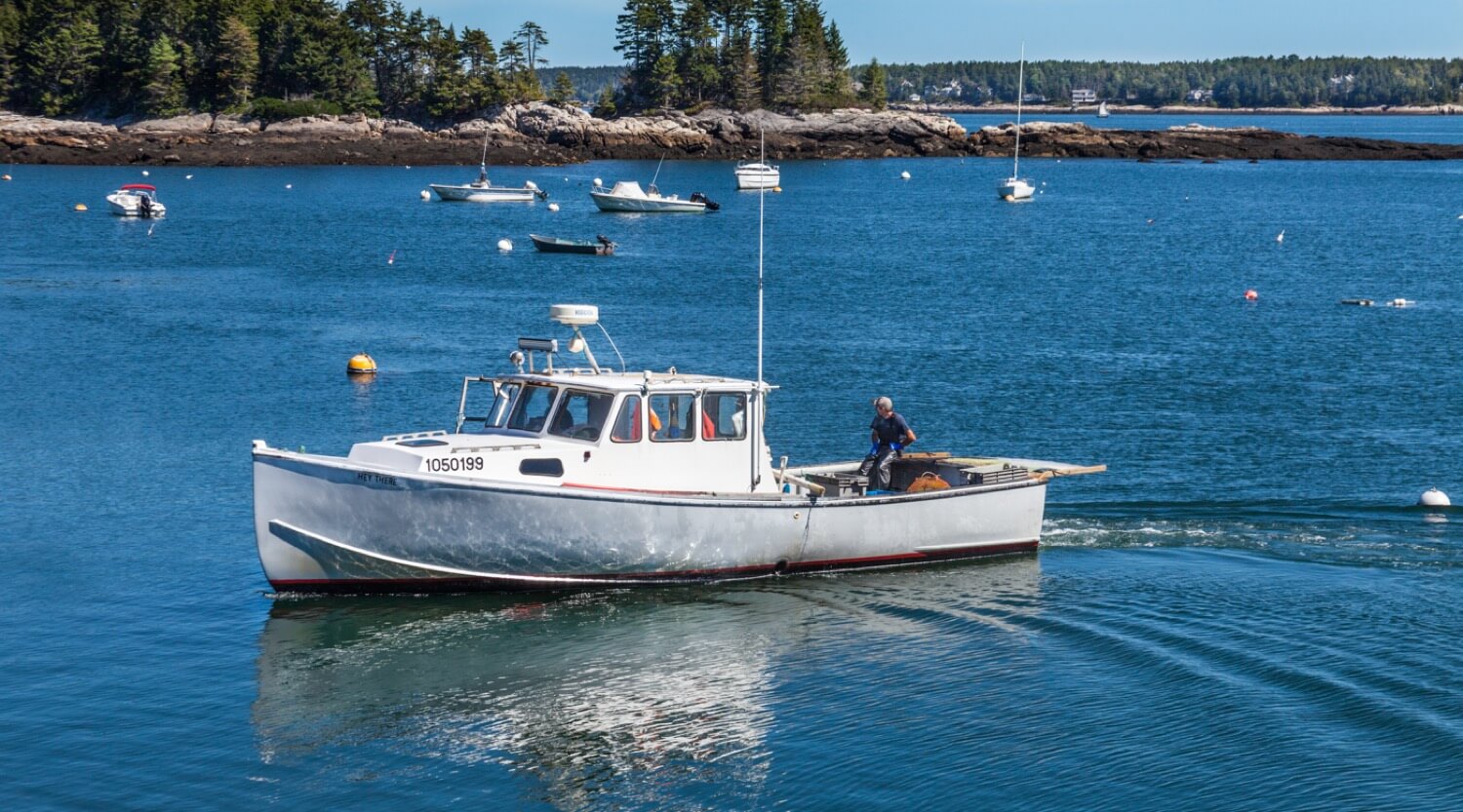
Semi-displacement hulls are smack bang in the center of planning and displacement hulls. They are a bit better for speed than displacement hulls are. They are a bit better for handling rough waters than planing hulls are. This makes them very versatile.
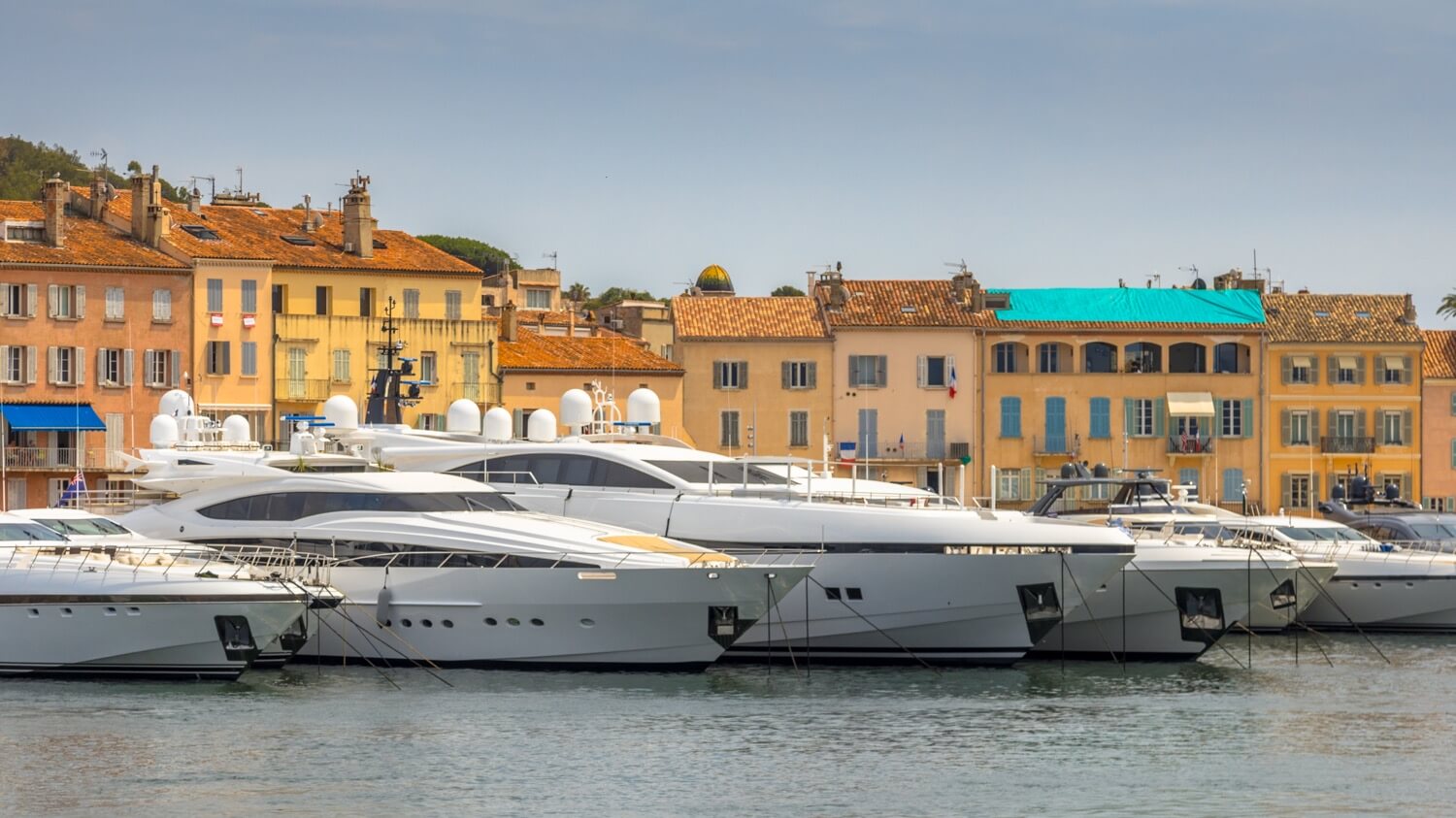
You can see these a bit like being 'half-planing' hulls. These hulls are designed to plane at lower speeds than normal planing hulls - somewhere in the range of 15 - 20 knots, depending on the length of the boat. It also requires less power. When the hull lifts, it reduces drag (water resistance), making it faster and more efficient.
Semi-displacement hulls are perfect for boats that need to be steady and seaworthy but fast at the same time.
For more information about semi-displacement hulls, please check out my in-depth guide to semi-displacement hulls here. It has a diagram and lists all the pros and cons.
Conclusion
So those were my 11 examples, and my step by step explanation of the different types of boat hulls and functions. You now have a solid basic understanding of boat hulls, and can recognize the most common ones. I hope it was helpful, and if you want more good sailing information, be sure to check out my other articles below.
Footnotes
Did you find the answer to your specific question?
👍 34 👎 16


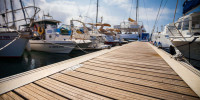
Comments
Kirk
I was wondering what your opinion would be on the ship uss Texas as far as hull type and bow type. I think it has a plumb bow and it looks to have a displacement or flat bottom hull. Im doing some research and a better trained eye would be of great help. I used images “bb-35 dry dock” to help see the hull shape. Thank you
Shawn Buckles
Hi Kirk, I don’t know about trained but here we go.
I’ve checked the picture, it’s definitely a displacement hull
I’d also say it’s a plumb bow.
Ur mum
Hahahahaa imagine liking boats hehehehehe Extremely stable & faster
Handles well in rough water Extremely stable & faster
Handles well in rough water Extremely stable & faster
Handles well in rough water Extremely stable & faster
Handles well in rough water Extremely stable & faster
Handles well in rough water Extremely stable & faster
Handles well in rough water Extremely stable & faster
Handles well in rough water Extremely stable & faster
Handles well in rough water Extremely stable & faster
Handles well in rough water
Leave a comment